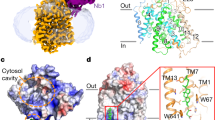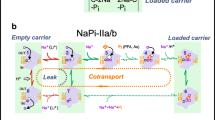Abstract.
The kinetics of Na+/d-glucose cotransport (SGLT) were reevaluated in rabbit renal brush border membrane vesicles isolated from the whole kidney cortex using a fast-sampling, rapid-filtration apparatus (FSRFA, US patent #5,330,717) for uptake measurements. Our results confirm SGLT heterogeneity in this preparation, and both high (HAG) and low (LAG) affinity glucose transport pathways can be separated over the 15–30°C range of temperatures. It is further shown that: (i) Na+ is an essential activator of both HAG and LAG; (ii) similar energies of activation can be estimated from the linear Arrhenius plots constructed from the V max data of HAG and LAG, thus suggesting that the lipid composition and/or the physical state of the membrane do not affect much the functioning of SGLT; (iii) similar V max values are observed for glucose and galactose transport through HAG and LAG, thus demonstrating that the two substrates share the same carrier agencies; and (iv) phlorizin inhibits both HAG and LAG competitively and with equal potency (K i = 15 μm). Individually, these data do not allow us to resolve conclusively whether the kinetic heterogeneity of SGLT results from the expression in the proximal tubule of either two independent transporters (rSGLT1 and rSGLT2) or from a unique transporter (rSGLT1) showing allosteric kinetics. Altogether and compared to the kinetic characteristics of the cloned SGLT1 and SGLT2 systems, they do point to a number of inconsistencies that lead us to conclude the latter possibility, although it is recognized that the two alternatives are not mutually exclusive. It is further suggested, from the differences in the K m values of HAG transport in the kidney as compared to the small intestine and SGLT1 cRNA-injected oocytes, that renal SGLT1 activity is somehow modulated, maybe through heteroassociation with (a) regulatory subunit(s) that might also contribute quite significantly to sugar transport heterogeneity in the kidney proximal tubule.
Similar content being viewed by others
Author information
Authors and Affiliations
Additional information
Received: 25 October 1995/Revised: 10 June 1996
Rights and permissions
About this article
Cite this article
Oulianova, N., Berteloot, A. Sugar Transport Heterogeneity in the Kidney: Two Independent Transporters or Different Transport Modes through an Oligomeric Protein? 1. Glucose Transport Studies. J. Membrane Biol. 153, 181–194 (1996). https://doi.org/10.1007/s002329900121
Issue Date:
DOI: https://doi.org/10.1007/s002329900121




